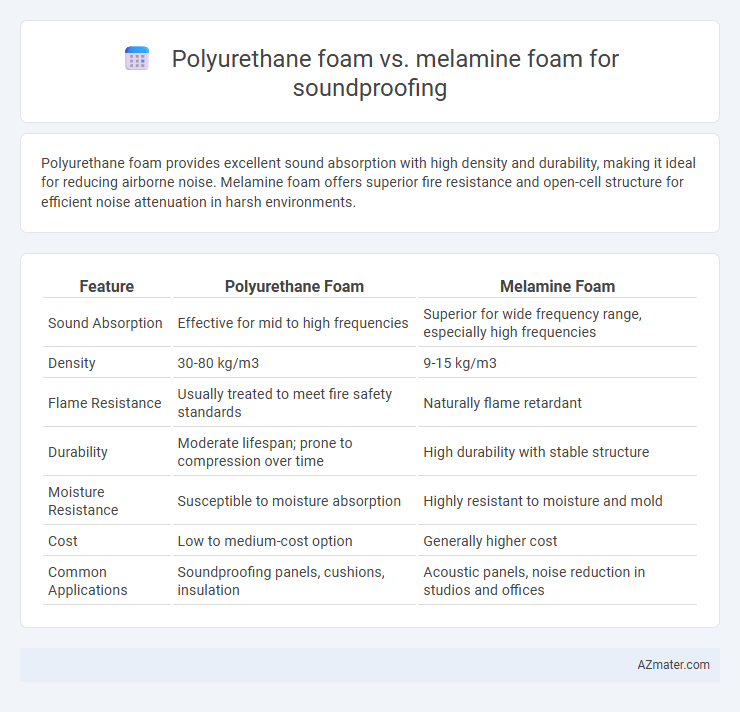Polyurethane foam provides excellent sound absorption with high density and durability, making it ideal for reducing airborne noise. Melamine foam offers superior fire resistance and open-cell structure for efficient noise attenuation in harsh environments.
Table of Comparison
| Feature | Polyurethane Foam | Melamine Foam |
|---|---|---|
| Sound Absorption | Effective for mid to high frequencies | Superior for wide frequency range, especially high frequencies |
| Density | 30-80 kg/m3 | 9-15 kg/m3 |
| Flame Resistance | Usually treated to meet fire safety standards | Naturally flame retardant |
| Durability | Moderate lifespan; prone to compression over time | High durability with stable structure |
| Moisture Resistance | Susceptible to moisture absorption | Highly resistant to moisture and mold |
| Cost | Low to medium-cost option | Generally higher cost |
| Common Applications | Soundproofing panels, cushions, insulation | Acoustic panels, noise reduction in studios and offices |
Understanding Polyurethane Foam and Melamine Foam
Polyurethane foam features a flexible, open-cell structure that effectively absorbs mid to high-frequency sound waves, making it a popular choice in acoustic treatment and soundproofing applications. Melamine foam possesses a rigid, open-cell design with superior fire resistance and excellent absorption of a broader range of sound frequencies, particularly effective in reducing high-frequency noise. Both materials offer distinct acoustic properties suited for different environments, where polyurethane foam excels in general sound absorption and melamine foam provides enhanced fire safety and performance in harsher conditions.
Acoustic Properties: Polyurethane vs Melamine Foam
Polyurethane foam offers excellent sound absorption due to its open-cell structure, effectively reducing mid-to-high frequency noise and providing good thermal insulation. Melamine foam, characterized by its rigid, open-celled network, excels in absorbing a broader frequency range including high-frequency sounds, while also providing superior fire resistance and durability. Both foams are widely used in acoustic treatment, but melamine foam typically delivers higher noise reduction coefficients (NRC) and better performance in harsh environments compared to polyurethane foam.
Noise Reduction Coefficient (NRC) Comparison
Polyurethane foam typically has a Noise Reduction Coefficient (NRC) ranging from 0.4 to 0.7, making it effective for general sound absorption across mid to high frequencies. Melamine foam offers an NRC of approximately 0.7 to 0.9, providing superior sound-absorbing properties, especially in higher frequency ranges, due to its open-cell structure and lightweight composition. When choosing between the two, melamine foam often delivers better noise reduction performance in environments requiring higher acoustic clarity and reduced reverberation.
Durability and Lifespan of Each Foam
Polyurethane foam exhibits higher durability and a longer lifespan compared to melamine foam, maintaining its soundproofing properties under prolonged exposure to environmental stress and physical compression. Melamine foam, while effective for acoustic absorption, tends to degrade faster due to its brittle structure, especially in high-humidity or high-traffic areas. Choosing polyurethane foam ensures sustained performance and reduced replacement frequency, making it ideal for long-term soundproofing applications.
Fire Resistance and Safety Considerations
Polyurethane foam offers good sound absorption but has lower fire resistance, often requiring treatment with fire retardants to meet safety standards. Melamine foam exhibits superior fire resistance due to its inorganic structure, providing self-extinguishing properties and reduced smoke emission during combustion. For soundproofing applications in environments prioritizing fire safety, melamine foam is a more reliable choice due to its enhanced flame retardancy and non-toxic smoke characteristics.
Installation and Application Scenarios
Polyurethane foam offers flexible installation options, ideal for irregular surfaces and large-scale commercial soundproofing projects due to its durable, dense composition. Melamine foam, being lightweight and highly porous, is best suited for acoustic panels and smaller, indoor applications where absorption of high-frequency noise is critical. Both materials require minimal maintenance, but polyurethane foam excels in environments needing robust impact resistance and thermal insulation alongside soundproofing.
Cost Comparison: Polyurethane vs Melamine Soundproofing
Polyurethane foam typically costs less per square foot compared to melamine foam, making it a budget-friendly option for soundproofing large areas. Melamine foam, while more expensive, offers superior fire resistance and enhanced acoustic properties, justifying its higher price in specialized applications. Choosing between polyurethane and melamine soundproofing hinges on balancing cost constraints with performance requirements and safety standards.
Environmental Impact and Sustainability
Polyurethane foam, derived from petrochemicals, poses significant environmental concerns due to its non-biodegradability and release of toxic chemicals during production and disposal. Melamine foam, made from a melamine-formaldehyde resin, offers a more sustainable alternative with better biodegradability and lower toxicity over its lifecycle. Choosing melamine foam supports eco-friendly soundproofing by reducing chemical emissions and minimizing landfill waste.
Aesthetics and Design Flexibility
Polyurethane foam offers greater design flexibility with a wide range of colors, densities, and shapes, making it ideal for custom acoustic panels and visually appealing soundproofing solutions. Melamine foam, while excellent for sound absorption due to its open-cell structure, typically comes in a rigid white or off-white color, limiting aesthetic options and requiring additional treatments or coverings for enhanced design. Both materials provide effective soundproofing, but polyurethane foam stands out in applications where visual integration and creative design are crucial.
Choosing the Right Foam for Your Soundproofing Needs
Polyurethane foam offers high-density cellular structure ideal for absorbing mid to high-frequency sounds, making it suitable for home studios and media rooms. Melamine foam, characterized by its open-cell structure and fire-resistant properties, excels in acoustic treatment and sound absorption in commercial and industrial environments. Selecting the right foam depends on factors such as frequency range, fire safety requirements, and budget constraints to optimize soundproofing performance.

Infographic: Polyurethane foam vs Melamine foam for Soundproofing
 azmater.com
azmater.com